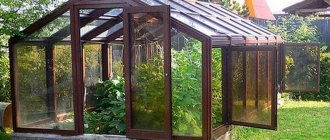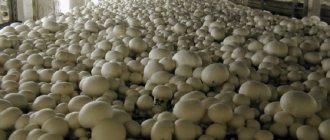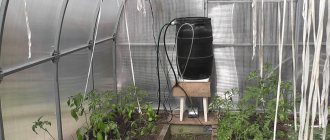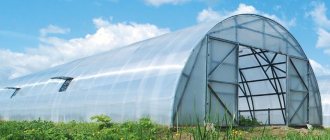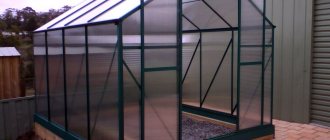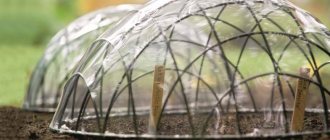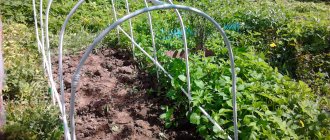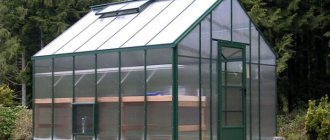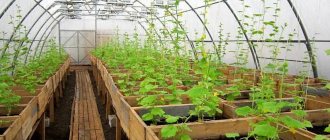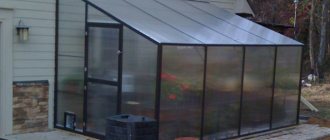A greenhouse is a frame structure, usually made of a metal profile, covered with a transparent, lightweight and durable material. The greenhouse maintains a certain microclimate necessary for growing the plants inside it. To obtain the result in the form of grown fruits, you need to put in a lot of time and physical effort, implementing a set of agrotechnical measures.
A smart greenhouse will make work easier, in which all the actions necessary for growing plants are carried out according to a program that controls special devices with virtually no human intervention.
The operating principle of a smart greenhouse
The diagram below of how a smart greenhouse works shows the extent of human participation in its functionality. User input is limited to software adjustments and direct setting of controller parameters. The adjustment can be carried out remotely through, for example, a computer connected to the controller.
The automatic operating mode is provided by sensors and a controller with electronic control circuits, which ensure the operation of the actuators in the required mode.
Possible difficulties with assembling an automatic greenhouse
Problems during greenhouse operation related to the operation of support systems may arise for the following reasons:
- errors when calculating the number of vents, programming sensors, etc.;
- system overload when using devices without taking into account their technical parameters;
- breakdowns as a result of ignoring preventive maintenance of equipment and timely signals about a malfunction;
- violation of safety regulations on the use of low-voltage voltage (12–36 V) indoors;
- Installing a polycarbonate greenhouse at temperatures below +10°C may cause damage to the material due to its fragility at low temperatures.
Creating a smart greenhouse is especially important where constant control over the conditions of keeping plants is impossible. You can use the capabilities of electronics in many processes, selecting optimal conditions for growing the desired crops.
Classification of smart greenhouses
Any system in which any action is performed must have external energy sources for this. According to the method of using such energy, smart greenhouses can be classified into the following groups:
- autonomous - uses natural sources of thermal energy, for example solar;
- dependent on industrial energy sources - power is supplied from the electrical network.
The disadvantage of an autonomous system is the inertia of the automatic system, which, due to untimely operation of the actuators, does not guarantee the normal functioning of plants.
Energy-dependent operating systems of a smart greenhouse may have an emergency shutdown, which will have the worst consequences for the plants.
Based on the design and purpose of greenhouse complex devices, the following categories can be distinguished.
- Greenhouse. This is a room for growing exotic plants for which the climate of the area is not suitable. Usually covered with glass and used for scientific purposes to study the development of unusual plants.
- Greenhouse. These are premises for year-round cultivation of vegetables, berries and seedlings. Covered with a lightweight transparent material such as polycarbonate. The main goal of greenhouses is to obtain a high yield of vegetables and berries in a short agrotechnical time frame, regardless of the surrounding weather conditions.
- Greenhouse. The main purpose of a greenhouse is to grow seedlings. Usually this is a small portable structure covered with an easily rolled transparent film. The heat in it is created by natural energy sources.
Basic features of a smart greenhouse
The following types of work from the complex of mandatory agrotechnical measures carried out with plants in a greenhouse are subject to automation.
- Regulating the temperature preferred for growing plants in that particular greenhouse. Control over maintaining a given thermal regime.
- Creation of certain indicators of air humidity in the greenhouse. This indicator has a significant impact on the yield of some crops.
- Maintaining soil moisture within specified limits. The root system of plants should not dry out, and at the same time, excess moisture leads to plant disease.
- The organization of additional lighting in the greenhouse at any time of the year will ensure full growth of plants.
Pros and cons of placing greenhouses on the site
First the pros:
- you will have the opportunity to eat early vegetables grown using your own technology without nitrates;
- your plants will be protected from bad weather and acid rain, which often falls in our time;
- garden pests will also be prevented from entering the structure.
Rice.
6 Garter of cucumbers And now about the disadvantages:
- for normal plant growth you need to water and fertilize the plants, spray them against diseases and viruses;
- carry out work related to gartering, removing excess shoots, and other actions to regulate plant growth.
All these actions take time, but in order to grow a good harvest, there is no other way. And if you make a “smart greenhouse”, then most of your worries will disappear. It is enough to spend a little time 1-2 times a week for gartering and removing excess shoots. You will come to the dacha only to monitor the growing and harvesting process.
Where can I buy
You can purchase equipment for smart greenhouses either in a specialized store or online in an online store. In the second case, the budget option for purchasing products on the Aliexpress website deserves special attention. For some products there is an option for shipment from a warehouse in the Russian Federation; they can be received as quickly as possible; to do this, when ordering, select “Delivery from the Russian Federation”:
| Automatic drive for opening Tuya window | Irrigation system with timer | Automatic watering kit for greenhouses with timer |
| Universal smart solution for remote monitoring of a greenhouse | LED grow light 1000/1500W | Smart lamp for plants with remote control |
Irrigation system
The next point in greenhouse automation will be the irrigation system . Plants need moisture and watering no less than air or lighting. You can automate watering using devices that can control the volume, pressure and time of watering. Today, drip, subsoil and rain irrigation systems are in demand.
- The drip system supplies water to the roots of plants, using a minimal amount of water. By the way, you can make such a drip irrigation system with your own hands.
- The subsoil system involves delivering moisture directly to the roots of plants, maintaining the structure of the soil and maintaining an optimal level of moisture (for example, using plastic bottles).
- The rain system works with the help of irrigation nozzles equipped at the top of the greenhouse. This is the simplest and evenly moisturizing design.
There is also a micro-drip irrigation system AquaDusya . How does it work? Find out here.
Sensors as the basis of information for a smart greenhouse
The following types of sensors, integrated in a digital format to transmit a signal to the controller, transmit time-varying parameters to the smart greenhouse control unit:
- air temperature sensors
- air humidity sensors
- soil temperature sensor
- soil moisture sensor
- light sensor
In addition to the sensors presented above, there are many others that some agricultural producers use in their activities: dew point sensors, soil chemical composition sensors, irrigation water quality control sensors and others.
We recommend reading: how to make a soil moisture sensor for an irrigation system with your own hands.
Heat storage
The first reason why greenhouses are installed is warmth . By maintaining optimal soil and air temperatures, you can achieve productivity in cold or too hot seasons.
The building can be heated using
electric heaters .
As an option, you can equip it with thermal insulation material for better heat accumulation (air bubble film, double glass, heat shields, wood).
When insulating a greenhouse, do not forget that heat can “escape” through cracked glass or ventilation openings and windows.
By insulating a greenhouse, solar energy , through which additional insulation and heating can be achieved.
It is possible to accumulate heat energy using pipes installed under the roof of the greenhouse, operating on reverse direction fans .
Controller
The controller processes information and gives commands for the actions of actuators. This is a programmable electronic device that, according to a given algorithm, ensures the implementation of all agrotechnical tasks for caring for plants.
In addition to the electronic circuit itself and a set of sensors, the delivery package includes control and visualization programs.
As an example, we give the functionality of one type of Russian-made controller:
- control according to a program designed to operate throughout the day, where the initial data are the values of temperature and humidity;
- the position of the thermal drive for opening the vents is regulated by an algorithm for finding its most effective position for solving the task;
- finds optimal cooling options during critically high summer temperatures;
- performs micro-ventilation mode while maintaining optimal humidity;
- organizes automatic watering in the greenhouse with the addition of water to the tank and control of the supply to the plants together with the supply of the nutrient solution;
- participates in the preparation of the nutrient solution, controlling its composition;
- controls the heating system based on sensor readings;
- performs calculations of solar energy received by plants in a certain period of time;
- controls humidity simultaneously in several zones;
- operates with temperature data at several specified points in the greenhouse.
This set of functions qualitatively improves the conditions for growing plants in a greenhouse.
We automate in a cunning way and using home remedies
Let's see how we can provide the same automatic watering to plants using improvised means:
Method No. 1. Solar distillation
This is a very simple method of automatic watering, which provides enough moisture for plants even on the hottest days. The essence of this principle is solar distillation - when water is heated until steam is released, and this steam is then condensed into water.
So, we take two plastic bottles of different sizes, pour water into one of them, and use the second as a cap for it. When the water from the sun evaporates, the steam will settle on the walls of the hood. This condensation moisturizes the soil well, and the hotter the sun, the more moisture the plants will receive.
Market overview of industrial manufacturers of smart greenhouses
The market for smart greenhouses is becoming increasingly resilient. This is facilitated by the development of the following technologies:
- application of additional lighting technology based on light-emitting diodes (LED technology);
- in addition to wired, wireless communication is used for connection;
- improvement of irrigation system designs;
- improvement of technical characteristics of pumps and valves;
- an increase in the number of factors that indicate the occurrence of an emergency situation during its monitoring;
- application of advanced achievements in the field of IT technologies.
Rated manufacturers of smart greenhouses offer their products depending on the size of the greenhouse complex; technical solutions are selected in accordance with the type of crops grown.
On an industrial scale, smart greenhouses are used in northern latitudes. Vegetables and fruits that are exotic for the northern regions and grown in smart greenhouses will be much cheaper than those imported from the southern regions.
The intelligent segment of agriculture in the form of smart greenhouses will develop at a rapid pace thanks to domestic manufacturers. The government's focus on the digital economy will contribute to this.
The Netherlands and some other European countries are at the forefront of developing controlled environment agriculture technologies. The implementation of smart greenhouses is developing at an accelerated pace in India, Japan, and China.
Dominant positions in the smart greenhouse market are occupied by Rough Brothers (USA), Heliospectra (Sweden), GreenTech Agro (Netherlands) and others.
DIY smart greenhouses
It is too expensive for a simple summer resident to invest in a ready-made automated greenhouse. However, you can take advantage of its benefits by making it yourself.
We recommend that you familiarize yourself with how to make a smart greenhouse using Arduino with your own hands, it will allow you to save money and customize the system the way you need.
Features of the design and location on the site
For effective operation of automation systems, the following recommendations should be followed.
- Choose a place on the site where, according to the geography of the area, the maximum flow of sunlight will penetrate through the transparent film. This will reduce the load on additional LED lighting and reduce the cost of maintaining the greenhouse.
- Design the greenhouse frame so that the vents are located in the upper part of the greenhouse. Cold air, entering the greenhouse through the window, will slowly fall down, and warm air will also gradually rise up. This arrangement of the vents eliminates the formation of drafts that are harmful to the development of plants. Sealing the film and tightly closing the doors will eliminate the influence of external weather conditions on the microclimate of the greenhouse.
- If the site is located in an area with high wind conditions, then protection should be performed in the direction of the dominant wind direction, for example, covering the greenhouse with a hedge.
- For year-round use of the greenhouse, equip it with heating devices that will automatically turn on/off using specially configured temperature sensors.
Do-it-yourself automatic ventilation
Air circulation in the greenhouse is ensured by opening vents or doors, which are equipped with automatic opening systems. Such devices can be made independently by modifying existing similar designs or made from available materials suitable for this purpose.
A classic example of use for automatic opening of greenhouse vents is modification of a gas shock absorber for a car. Hydraulic oil, acting as a working fluid, instead of air, under the influence of elevated temperature, expands and sets the window in motion. When the temperature drops, the window closes using a return spring.
In a similar way, a gas lift from an office chair, hand pumps and other technical equipment can be adapted to ventilate greenhouses. From available means, for example, plastic bottles or a metal container that fills a rubber ball with air as the temperature rises, temporary structures can be made that provide automatic ventilation of greenhouses.
Do-it-yourself automatic watering
A standard do-it-yourself automatic watering system includes the following components.
- A source of water is required. This can be a tank in the form of a barrel, into which water is periodically poured from a well, a water supply system, or using a pump from a country pond. In a barrel, the water temperature over time approaches the ambient temperature, which is important for the life processes of plants.
- Availability of a filter. Without it, the pipeline quickly becomes clogged. Its absence is especially critical for drip irrigation systems.
- Solenoid valves. Their design allows you to control the signaling of the beginning and end of the watering process.
- Timer. Its settings transmit signals to open/close solenoid valves.
- A system of steel, plastic (possibly rubber for drip irrigation) or metal-plastic pipelines. Provides water delivery, for example, during drip irrigation to capillary tubes.
If the system has temperature and soil moisture sensors, it is possible to automatically turn on/off automatic irrigation based on their readings.
We also recommend reading about ready-made automatic watering systems for greenhouses.
Do-it-yourself automated heating
With the help of heating systems, it will be possible to maintain the temperature in the greenhouse in any weather and at any time of the year.
The greenhouse heating system can be equipped as follows:
- pass the heating cable inside the floor;
- use heating devices for heating (oil radiator, infrared emitter and other similar installations);
- floors can be heated using warm water pipes.
The most convenient heating automation option is based on using a heating cable inside the floor. The ends of the cable after laying are connected to the adjusting device. It is important that this heating system directly warms the soil and thus has an advantage over heating devices that affect the heating of the air.
Do-it-yourself installation and arrangement of automatic equipment for additional lamps
Not only high-quality soil and timely watering, but also optimal lighting will help you get a good harvest. When operating a greenhouse in winter, there is clearly not enough daylight due to the short day.
As additional lighting, LED lamps are the most competitive in terms of their characteristics. They are characterized by low power consumption and produce a large part of the solar spectrum. There are white LEDs that can produce the full spectrum of sunlight and help grow plants entirely in artificial light.
To supply power to the power cabinet, you need to route overhead wiring from the high voltage network. It is better to entrust this work to professional electricians who have the right of access to such work. Further laying of the wire in the ground is done by hand.
Important: first place the wire in a protective corrugated hose.
A safety device must be installed to protect against voltage surges. Its selection is based on the recommendations of the LED lamp manufacturer. After installing the device, wiring is carried out according to the location of the lamps.
To create optimal illumination, an automatic system is created, which, among other things, will save energy. Special sensors will monitor the lighting and automatically turn the backlight on or off.
Preservation of beneficial soil qualities
The smart greenhouse uses mulching of the soil environment. This agricultural technique reduces the time required to maintain the fertile qualities of the soil. It is enough to cover its surface once with mulch (natural organic materials) and the moisture content in the soil is maintained for a long time, weeds disappear. In winter and autumn, additional cover with non-woven agricultural material provides warmth to the soil and air. Moisture is retained inside after evaporation on the inside of the covering material and flows back into the ground.
In the summer, the covering material is removed - sawdust or straw is evenly scattered in its place, on the contrary, preserving the soil from excess heat.
Equipping a greenhouse at your dacha with smart technology with your own hands is not an easy task. Some experience and knowledge will be required, and investment is also indispensable. However, all the not-so-large financial costs will be repaid with a good harvest and free time for rest and doing other equally important things.
Benefits of greenhouse automation
Protection against temperature changes and extreme temperatures
Maintaining and controlling the temperature range in the greenhouse environment is critical. Temperature fluctuations can damage or kill plants within a few hours. Remote monitoring systems protect valuable plants from extreme temperature fluctuations.
Control of inventory and other equipment
In addition to maintaining the optimal temperature, it is necessary to ensure the safety of equipment and the efficient operation of air conditioning systems, maintaining humidity, etc.
The sooner a farmer detects a drop in temperature or equipment failure, the greater the chance of saving property and plants. Remote monitoring systems send updates in real time, so enterprise employees can quickly respond to threats.
Monitoring the situation
If any condition falls outside a preset range, the devices or system immediately alerts responsible personnel by phone, email or SMS. Emergency notifications typically alert farmers to:
- Decrease in temperature;
- Poor ventilation;
- High levels of carbon dioxide;
- Changes in humidity;
- Equipment failure;
- Water leakage.
Prevention of diseases during the growing season
During the growing season, systems in smart greenhouses can monitor various environmental conditions. For this, both wired and wireless sensors are used. Maintaining temperature, humidity levels, lighting, and air circulation are critical to preventing mold, disease, and maximizing plant yield.
